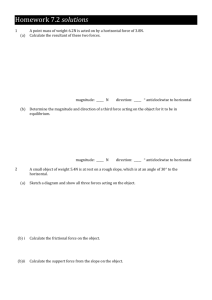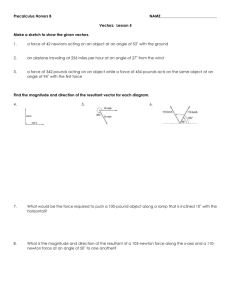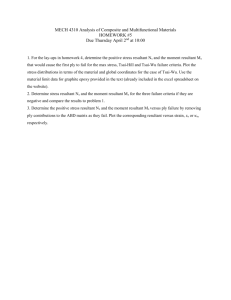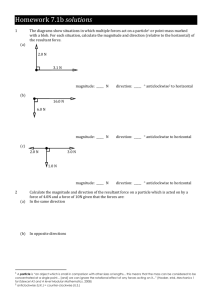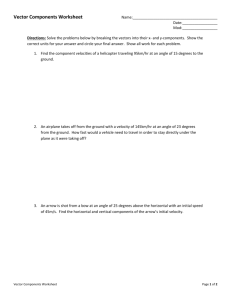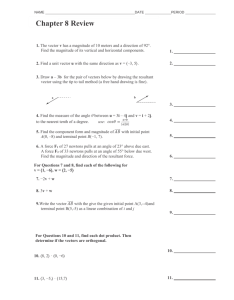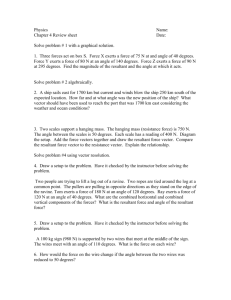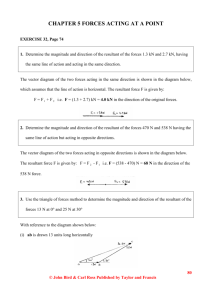Topic 9: The equilibrium of particles and rigid bodies
advertisement
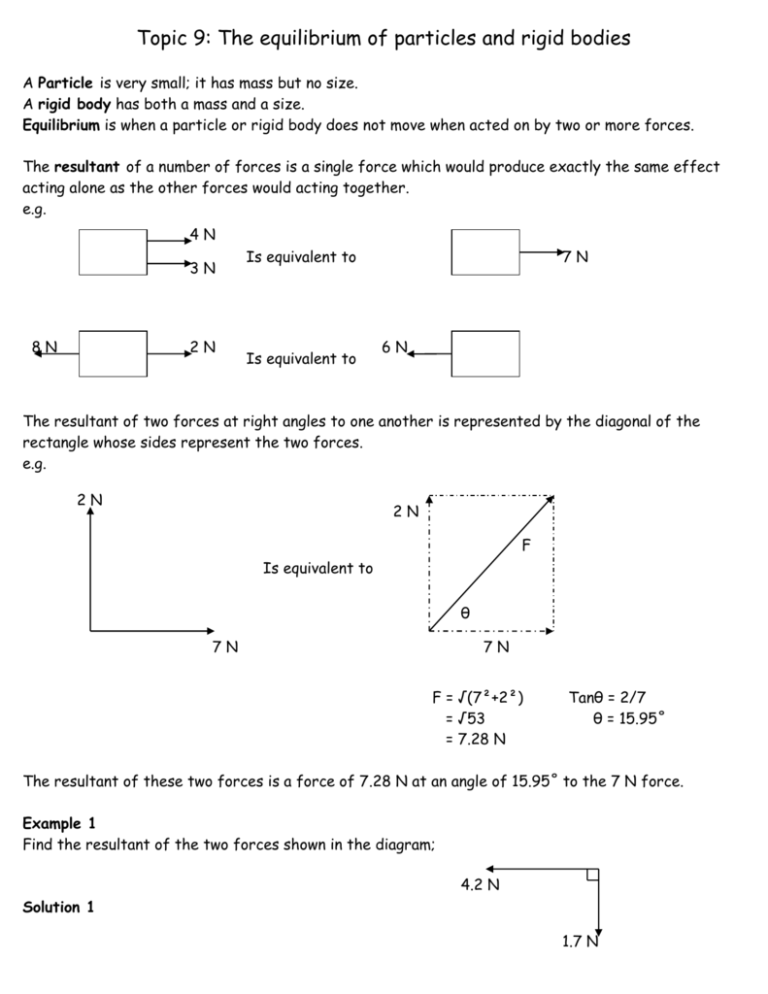
Topic 9: The equilibrium of particles and rigid bodies A Particle is very small; it has mass but no size. A rigid body has both a mass and a size. Equilibrium is when a particle or rigid body does not move when acted on by two or more forces. The resultant of a number of forces is a single force which would produce exactly the same effect acting alone as the other forces would acting together. e.g. 4N 3N 8N 2N Is equivalent to Is equivalent to 7N 6N The resultant of two forces at right angles to one another is represented by the diagonal of the rectangle whose sides represent the two forces. e.g. 2N 2N F Is equivalent to θ 7N 7N F = √(7²+2²) = √53 = 7.28 N Tanθ = 2/7 θ = 15.95˚ The resultant of these two forces is a force of 7.28 N at an angle of 15.95˚ to the 7 N force. Example 1 Find the resultant of the two forces shown in the diagram; 4.2 N Solution 1 1.7 N 4.2 N θ 1.7 N F F = √(4.2² + 1.7²) = 4.531 N Tanθ = 1.7/4.2 θ = 22.04˚ Hence the resultant of the two forces is a force of 4.532 N at an angle of 22.04˚ below the 4.2 N force. Since any two forces can be combined to produce a resultant, then any force can be resolved into two perpendicular forces called the components of the force. (We have already seen this in topic 5 and 6) A single force F at an angle θ to the horizontal can be split into perpendicular forces Fcosθ in the horizontal direction and Fsinθ in the vertical direction. e.g. 7sin27 = 3.18 N 7N Is equivalent to 27˚ 7cos27 = 6.42 N Example 2 Demonstrate that the system of forces on the left is equivalent to the single force on the right. 8N 12 N 60˚ 30˚ 10 N 40.4˚ 16 N Solution 2 To find the resultant first resolve all forces horizontally and vertically 4.74 N Force 10 N 16 N 8N 12N Total Horizontal component 10 0 8cos60 = 4 -12cos30 = -10.392 3.608 N Vertical component 0 -16 8sin60 = 6.928 12sin30 = 6 -3.072 N The resultant is; 3.608 N θ F F = √(3.608² + 3.072²) = √(13.02 + 9.44) = √(22.46) = 4.74 N Tanθ = 3.072/3.608 Θ = 40.4˚ 3.072 N Example 3 The system of 3 forces on the left is equivalent to the single resultant F at an angle θ to the horizontal. Find F and θ. 4N F 3N 17˚ 42˚ θ 1.8 N Solution 3 Force 1.8 N 3N 4N Total Horizontal component 0 -3cos17 4cos42 0.1037 N Vertical component -1.8 3sin17 4sin42 1.754 N 1.754 N F θ 0.1037 N F = √(1.754² + 0.1037²) = 1.757 N Tanθ = 1.754/0.1037 θ = 86.61˚ Example 4 A particle of mass 4 kg is attached to the lower end of a light inextensible string. The upper end is fixed to a wall. A horizontal force of P Newton’s is applied to the free end of the string so that the string makes an angle of θ with the downward vertical and experiences a tension of 200 N. If the 4 kg mass rests in equilibrium find P and θ. Solution 4 θ 200 θ P 4g Resolving Vertically 200cosθ = 4g cosθ = 4 x 9.8 ÷ 200 cosθ = 39.6 ÷ 200 cosθ = 0.198 θ = 78.58˚ Resolving horizontally 200sinθ = P 200sin78.58 = P 200 x 0.98 = P P = 196.04 N Example 5 A particle of mass m kg is attached to the lower end of a light inextensible string, the upper end of which is fixed to a wall. A horizontal force of 40 N is applied to the free end of the string so that the string makes an angle of θ with the downward vertical and experiences a tension of 90 N. If the particle rests in equilibrium find θ and m. Solution 5 θ 90 N θ 40 N mg Resolving horizontally 90sinθ = 40 sinθ = 40 ÷ 90 sinθ = 0.444 θ = 26.39˚ Resolving vertically 90cosθ = mg 90cos26.39 = mg 90 x 0.896 = 9.8m 80.623 = 9.8m 80.623 ÷ 9.8 = m m = 8.23 kg Example 6 A body of mass 5 kg is supported by two inextensible strings, the other ends of which are attached to 2 fixed points P and Q on a ceiling. The 5 kg mass rests in equilibrium with one string experiencing a tension T Newton’s and inclined at 30˚ to the horizontal and the other experiencing a force of S Newton’s and inclined at 45˚ to the horizontal. Find T and S. Solution 6 T S 45˚ 30˚ 5g Resolving horizontally Scos45 = Tcos30 0.707S = 0.866T S = (0.866 X T) ÷ 0.707 S = 1.225 T ………………….(1) Resolving vertically Ssin45 + Tsin30 = 5g 0.707S + 0.5T = 5 x 9.8 0.707S + 0.5T = 49 ………….(2) Substitute (1) into (2) 0.707 x 1.225T + 0.5T =49 0.866T + 0.5T = 49 1.366T = 49 T = 49 ÷ 1.366 T = 35.87 N So; S = 1.225 x 35.87 S = 43.93 N
